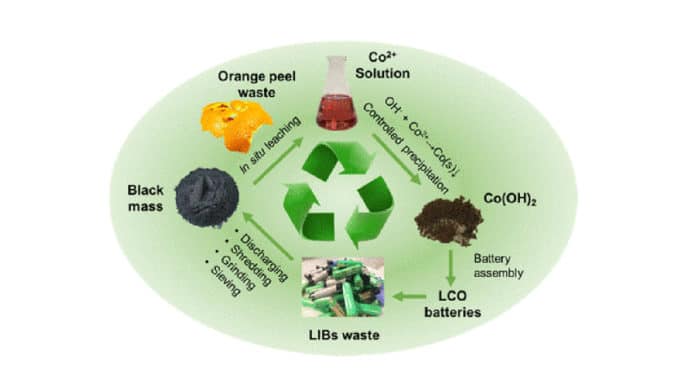Scientists led by Nanyang Technological University, Singapore (NTU Singapore) have come up with a waste-to-resource approach that includes fruit peel waste to turn old batteries into new. The concept was demonstrated using orange peel, which recovered precious metals from battery waste efficiently. These recovered metals was then used to make functional batteries.
An estimated 1.3 billion tonnes of food waste and 50 million tonnes of e-waste are generated globally. This new approach tackles both food waste and electronics waste, supporting a circular economy with zero waste.
Professor Madhavi Srinivasan, co-director of the NTU Singapore-CEA Alliance for Research in Circular Economy (NTU SCARCE) lab, said: “Current industrial recycling processes of e-waste are energy-intensive and emit harmful pollutants and liquid waste, pointing to an urgent need for eco-friendly methods as the amount of e-waste grows. Our team has demonstrated that it is possible to do so with biodegradable substances.”
“These findings build on our existing body of work at SCARCE under NTU’s Energy Research Institute (ERI@N). The SCARCE lab was set up to develop greener ways of recycling e-waste. It is also part of the NTU Smart Campus initiative, which aims to develop technologically advanced solutions for a sustainable future.”
Assistant Professor Dalton Tay of the NTU School of Materials Science and Engineering and School of Biological Sciences said: “In Singapore, a resource-scarce country, this process of urban mining to extract valuable metals from all kinds of discarded electronics becomes very important. With this method, we not only tackle the problem of resource depletion by keeping these precious metals in use as much as possible but also the problem of e-waste and food waste accumulation – both a growing global crisis.”
Scientists first oven-dried the orange peel and ground into powder. They added citric acid into the powder.
The cellulose found in orange peel was converted into sugars under heat during the extraction process. These sugars enhance the recovery of metals from battery waste. Naturally-occurring antioxidants found in orange peel, such as flavonoids and phenolic acids, could have contributed to this enhancement as well.
Scientists observed that the concept extracted around 90 percent of cobalt, lithium, nickel, and manganese from spent lithium-ion batteries during the lab experiment.
Scientists then assembled new lithium-ion batteries from the recovered material—these batteries showed a similar charge capacity to commercial ones.
Further research is underway to optimize the charge-discharge cycling performance of these new batteries made from recovered materials. Scientists are also looking to improve further the performance of their batteries generated from treated battery waste.
Prof Madhavi, who is also from NTU’s School of Materials Science and Engineering and ERI@N, said: “This waste-to-resource approach could also potentially be extended to other types of cellulose-rich fruit and vegetable waste, as well as lithium-ion battery types such as lithium iron phosphate and lithium nickel manganese cobalt oxide. This would help make great strides towards the new circular economy of e-waste, and power our lives in a greener and more sustainable manner.”
Journal Reference:
- Zhuoran Wu et al. Repurposing of Fruit Peel Waste as a Green Reductant for Recycling of Spent Lithium-Ion Batteries. DOI: 10.1021/acs.est.0c02873
